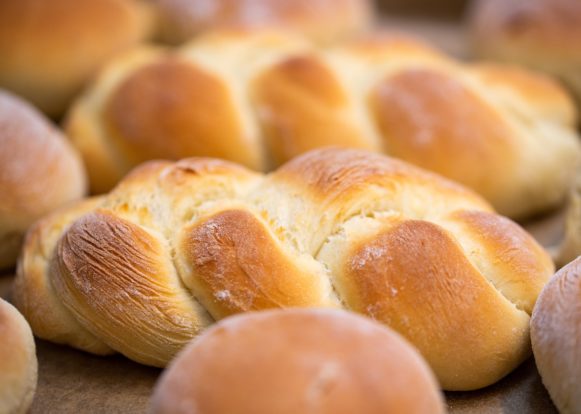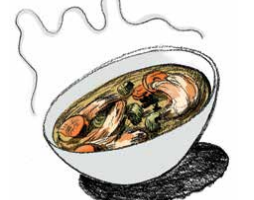Lilith Feature
The Foremothers of Food Memoirs
Like Mimi Sheraton, Colwin did not keep kosher. Unlike Sheraton’s, Colwin’s food memoirs contain scant mention of Judaism, though in the Home Cooking chapter “Friday Night Supper” she writes, “It is a night when the heart of even the most assimilated Jew cries out for something more substantial than one skinless chicken breast.” So Colwin offers recipes for pot roast and her mother’s potato pancakes. Her books also include recipes for staples like roast chicken, lentil soup, and gingerbread, as well as equally homey but unexpected dishes like yam cakes with hot pepper and fermented black beans, and peach pizza.
“Part of the reason her stuff resonates today is that amidst all the perfection that is presented in food media, old and new—the perfect dinner party, the most beautiful pie crust decoration, the happiness depicted on the plates and the tables in magazines and on Instagram,” Colwin revealed “the imperfection and messiness that is cooking and food and eating,” Davis says. Because “It isn’t pretty most of the time. And much of that reality was left out of the media. With Colwin, food writing could also be about not what’s perfect, but about what’s personal, and the process.”
From Niche Genre to the Cultural Mainstream
Though neither Mimi Sheraton nor Laurie Colwin was the first to take this approach to memoir, these immensely accomplished writers offered “a window into a domestic space that is quite different from [traditional] memoirs, which tell stories about famous people doing the things famous people do,” says Davis. Memoirs like these—some of them by well-known chefs—accounted for many of the approximately 30 women’s memoirs-with-recipes that Nathans-Kelly found during her research for Burned Sugar Pie in the mid-1990s. Today, few contemporary food memoirists are famous, at least not prior to publication. Instead they, like Sheraton and Colwin, share stories about everyday people—themselves.
In 1996, Claudia Roden published The Book of Jewish Food: An Odyssey from Samarkand to New York. Its 634 pages (plus index) include Roden’s memories of her family’s life in Egypt, and the food she ate growing up there. Personal anecdotes also appear throughout the book, in the historical essays that introduce a region’s Jewish cuisine and in discussions of particular foods.
 Unlike Sheraton and Colwin, Roden didn’t originally plan to include autobiographical material. Instead, she writes, “When I decided (as I did several times) to give up, my editor, Judith Jones, convinced me that the only way to deal with the subject was to make the book a ‘personal odyssey’ and to forget about trying to be comprehensive.” Though with 800+ recipes from all over the world and an emphasis on once-overlooked Sephardi foods, The Book of Jewish Food nonetheless is pretty comprehensive. Fortunately, she adds, “This was a very appealing idea…” Her approach was clearly successful—The Book of Jewish Food won the James Beard Foundation’s Cookbook of the Year award in 1997.
Unlike Sheraton and Colwin, Roden didn’t originally plan to include autobiographical material. Instead, she writes, “When I decided (as I did several times) to give up, my editor, Judith Jones, convinced me that the only way to deal with the subject was to make the book a ‘personal odyssey’ and to forget about trying to be comprehensive.” Though with 800+ recipes from all over the world and an emphasis on once-overlooked Sephardi foods, The Book of Jewish Food nonetheless is pretty comprehensive. Fortunately, she adds, “This was a very appealing idea…” Her approach was clearly successful—The Book of Jewish Food won the James Beard Foundation’s Cookbook of the Year award in 1997.
Then, in 1998, Ruth Reichl published Tender at the Bone: Growing up at the Table. Like Sheraton’s, Reichl’s first memoir-with-recipes was published while she was the New York Times restaurant critic. Tender at the Bone received rave reviews, and was a bestseller. Both it and its 2001 sequel, Comfort Me With Apples: More Adventures at the Table, use food, and cooking, as a way to explore themes of family, love, home, and discovery.
Davis says, “If there is a master of the genre, I think it is she…Ruth’s writing connects [with readers] in a very profound way.” Reichl’s most recent book is Save Me the Plums: My Gourmet Memoir. It’s not exactly a food memoir; instead, it’s about the business of writing about food—Reichl was editor in chief of the storied Gourmet magazine from 1999 until its shuttering in 2009.
In This Feature
Elizabeth Michaelson Monaghan
From M.D. to Baker, Beth Ricanati’s Memoir of ChallahCalifornia-based physician Beth Ricanati is the author of Braided: A Journey of a Thousand Challahs (She Writes Press, 2018), a chronicle of her decade of weekly challah baking and its spiritual benefits. Elizabeth Michaelson asks her some questions.





